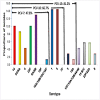Surveillance of impact of PCV-10 vaccine on pneumococcal meningitis in Mozambique, 2013 - 2015
- PMID: 28604773
- PMCID: PMC5467806
- DOI: 10.1371/journal.pone.0177746
Surveillance of impact of PCV-10 vaccine on pneumococcal meningitis in Mozambique, 2013 - 2015
Abstract
Background: Vaccination using the 10-valent conjugate vaccine (PCV-10) was introduced into the Extended Program on Immunization in Mozambique in March 2013, however its impact on pediatric pneumococcal meningitis is unknown. In this study, we assessed for the first time the impact of PCV10 on the burden of pneumococcal meningitis in children less than 5 years of age at the three largest hospitals in Mozambique.
Method: Between March 2013 and December 2015, a total of 744 cerebrospinal fluid (CSF) samples were collected from eligible children, of which 160 (21.5%) were positive for S. pneumoniae. Of these, only 86 samples met the criteria for serotyping and were subsequently serotyped using sequential multiplex PCR (SM-PCR), but 17 samples were non-typable.
Results: The proportion of cases of pneumococcal meningitis decreased from 33.6% (124 of 369) in 2013 to 1.9% (3 of 160) in 2015 (p < 0.001). The relative frequency of PCV10 serotype cases also decreased from 84.2% (48 of 57) in 2013 to 0% (0 of 3) in 2015 (p = 0.006). Between 2013 and 2015, serotype coverage of PCV-10 and PCV13 vaccine formulations was 66.7% and 81.2%, respectively.
Conclusion: Altogether, our findings shows that introduction of PCV-10 immunization resulted in rapid decline of pneumococcal meningitis children less than 5 years old in Mozambique. This decline was accompanied by substantial changes in the pattern of circulating pneumococcal serotypes.
Conflict of interest statement
Figures




References
-
- Ladhani SN, Slack MP, Andrews NJ, Waight PA, Borrow R, Miller E. Invasive pneumococcal disease after routine pneumococcal conjugate vaccination in children, England and Wales. Emerg Infect Dis 2013; 19:61–8. doi: 10.3201/eid1901.120741 - DOI - PMC - PubMed
-
- Baraff LJ, Lee SI, Schriger DL. Outcomes of bacterial meningitis in children: a metaanalysis. Pediatr Infect Dis J 1993; 12:389–94. - PubMed
-
- Pilishvili T, Lexau C, Farley MM, Hadler J, Harrison LH, Bennett NM, et al. Sustained reductions in invasive pneumococcal disease in the era of conjugate vaccine. J Infect Dis. 2010; 201: 32–41. doi: 10.1086/648593 - DOI - PubMed
-
- Miller E, Andrews NJ, Waight P, Slack M, George R. Herd immunity and serotype replacement four years after pneumococcal conjugate vaccination in England and Wales: an observational cohort study. Lancet Infect Dis. 2011; 11: 760–8. doi: 10.1016/S1473-3099(11)70090-1 - DOI - PubMed
Publication types
MeSH terms
Substances
Grants and funding
LinkOut - more resources
Full Text Sources
Other Literature Sources
Molecular Biology Databases
Miscellaneous

